Pioneering Circularity to Keep within Boundaries
Most of us are familiar with the goal of keeping global warming within 1.5 degrees Celsius, a target set internationally in the Paris Agreement. Overstepping that “defense line” could lead to climate impacts increasingly harmful for people and the planet.
But the threshold for global warming is only one of a list of critical “planetary boundaries” – limits on human activity and its impact to ensure the stability of earth’s key system identified by a team of scientists 15 years ago – which we must heed. The others are thresholds for not just climate change, but also biodiversity, freshwater use, nutrient use in fertilizers, and air pollution.1
In May 2023, the same team of scientists reported that humanity has broken through four of five system boundaries. Not only have we passed the “safe” limits to ensure the stability of the planetary system, but we have also strayed far beyond “just boundaries” set at lower thresholds to minimize significant harm to people.2
These findings naturally mean urgent action is required on all fronts.
"Nothing less than a just global transformation across all Earth system boundaries is required to ensure human well-being. It requires a leap in our understanding of how justice, economics, technology and global cooperation can be furthered in the service of a safe and just future."3
- Scientists write in their article for Nature
Reviving Water
Though these challenges are daunting, there are no planetary boundaries to human ingenuity and determination.
Remarkable progress has been made in some cases by efforts to bring together emergent tech, financing, outreach, as well as rulemaking to achieve circular economy solutions. Consider the Pure Water Project being undertaken by the Las Virgenes Municipal Water District (LVMWD), located in Los Angeles County, California.
The city, like many others globally, face severe water stress and scarcity due to climate change and a growing population. Treated wastewater is seen in many of these regions to become a vital renewable source of water. By the end of 2023, Californian regulations will allow for the direct reuse of reclaimed water for drinking in addition to the currently permitted indirect reuse, which replenishes treated water into an environmental buffer – like an underground aquifer and reservoir – before sending them into drinking water treatment facilities.4 The Pure Water Project aims to demonstrate that current technologies can produce drinkable water from highly treated wastewater in compliance with water quality standards set locally.
It is also part of longstanding outreach efforts to gain public acceptance for the potable reuse of reclaimed water.5 LVMWD offers regular tours to educate the public about the importance and necessity of, as well as opportunity to taste, the purified water. The treated water from the facility has also been used to brew a lager beer under the brand name Revival to generate support.6

Federal, state, and municipal governments are supporting the Pure Water Project by LVMWD.7 And an international team including the US Bureau of Reclamation, the National Water Research Institute, the Japan’s Ministry of Economy, Trade and Industry, and various private companies are providing backing.8
Treating water to potable quality is a major technical challenge. The process consumes enormous amounts of electricity and is maintenance intensive, while wastewater loads in quality and flow rate are also highly variable depending on the time and season, making it difficult to optimize operations.
Yokogawa, a Japanese technology company with expertise in monitoring and controlling industrial facilities, sees this space as ideally suited for applying its core competencies. By using its advanced digital technologies and AI, Yokogawa was able to generate a model based on past operation records at the Tapia Water Reclamation Facility operated by LVMWD and provide energy optimization of the aeration system which is directly linked to wastewater treatment capabilities.
Using data collected on the Yokogawa Cloud platform, the operators of the facility were able to reduce power consumption related to the aeration system by over 10 per cent, while maintaining the water quality of effluent against discharge limit standards.9 The solutions has also helped reduce treatment costs and maintenance costs of equipment, while maximize the output.
Yokogawa is developing advanced AI-based and semi-autonomous wastewater treatment solutions for potable re-use. Expanding such pilot schemes that expand our ability to optimize the treatment of wastewater is a pressing and important task. The World Bank estimates that 80% of global wastewater is not adequately treated and as much as a third of the global population lives in water-scarce areas.10 More revived water will help us keep within planetary boundaries.
Upcycling Food
Humanity needs water, but also food. Yet global food production is also responsible for significant environmental costs including greenhouse gas-emissions, damaging release of excess nitrogen and phosphorus inputs into our biosphere and oceans, loss of biodiversity, depletion of freshwater resources. Scientists expect that without adequate technological changes and mitigation measures, such as reducing food loss and waste, rising population and income levels will accelerate these adverse environmental effects for food production beyond our planetary boundaries.11
Here too Yokogawa is involved in advancing circular solutions.

In September 2023, Yokogawa’s subsidiary, Yokogawa Solution Service, announced a project with Phytochem Products, a Japanese startup, to develop a technology for the extraction of functional ingredients from by-products that have been discarded in the production process of vegetable oils.
The production of these oils generates a considerable amount of by-products containing tocotrienol (super vitamin E), tocopherol (vitamin E), phytosterol. Because it is usually difficult and unprofitable to recover these functional ingredients, requiring high temperature and high vacuum conditions, most of the by-products are discarded.
Phytochem has a unique technology for extracting useful ingredients from the by-products using ion exchange resins. The process dramatically raises yields, reduces energy inputs, and does not involve toxic substances such as methanol or toluene in extraction.12 The oil remaining after the extraction of functional ingredients can be used as a biofuel for power generation, which achieves full utilization of unused biomass resources. Yokogawa, in turn, has expertise in the real-time analysis, estimation, and measurement of functional ingredients as well as modeling technology for the automation and optimization of the recovery process.
By collaborating on their strengths, the two companies hope to reduce the waste of biomass resources in the production of vegetable oils and help in the upcycling of food for a circular economy.13
Towards a Flourishing Circular Society
Keeping within “safe” and “just” planetary boundaries will require a reboot of our politics, economics, and technology across all sectors from energy, food, to cities. Resources must be reduced, reused, recycled, and reallocated to ensure access for all people. And this green transition will require vast public and private funding, including the help of startups and venture capital,14 legislation and international agreements, as well as a shift in consumer and social attitudes.
As the circular approach projects for water and food demonstrate, these steep and multifaceted challenges can be overcome through innovation and cooperation.
Yokogawa is working not only here but across a broad range of industries, including energy, chemicals, materials, pharmaceuticals, and food, to help optimize processes for customers and our future generations.
Its purpose is to drive forward the Green Transformation, together with partners and leveraging its unique know-how in “measuring” and “connecting” industrial processes. The end vision is to realize a “flourishing circular society”15 within our planetary boundaries.
